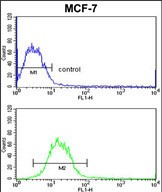SNRPB Antibody (N-term R49)
Purified Rabbit Polyclonal Antibody (Pab)
- SPECIFICATION
- CITATIONS: 1
- PROTOCOLS
- BACKGROUND

Application
| FC, WB, E |
|---|---|
| Primary Accession | P14678 |
| Other Accession | P17136, P27048, Q58DW4 |
| Reactivity | Human |
| Predicted | Bovine, Mouse, Rat |
| Host | Rabbit |
| Clonality | Polyclonal |
| Isotype | Rabbit IgG |
| Calculated MW | 24610 Da |
| Antigen Region | 34-65 aa |
| Gene ID | 6628 |
|---|---|
| Other Names | Small nuclear ribonucleoprotein-associated proteins B and B', snRNP-B, Sm protein B/B', Sm-B/B', SmB/B', SNRPB, COD, SNRPB1 |
| Target/Specificity | This SNRPB antibody is generated from rabbits immunized with a KLH conjugated synthetic peptide between 34-65 amino acids from the N-terminal region of human SNRPB. |
| Dilution | FC~~1:10~50 WB~~1:1000 E~~Use at an assay dependent concentration. |
| Format | Purified polyclonal antibody supplied in PBS with 0.09% (W/V) sodium azide. This antibody is prepared by Saturated Ammonium Sulfate (SAS) precipitation followed by dialysis against PBS. |
| Storage | Maintain refrigerated at 2-8°C for up to 2 weeks. For long term storage store at -20°C in small aliquots to prevent freeze-thaw cycles. |
| Precautions | SNRPB Antibody (N-term R49) is for research use only and not for use in diagnostic or therapeutic procedures. |
| Name | SNRPB |
|---|---|
| Synonyms | COD, SNRPB1 |
| Function | Plays a role in pre-mRNA splicing as a core component of the spliceosomal U1, U2, U4 and U5 small nuclear ribonucleoproteins (snRNPs), the building blocks of the spliceosome (PubMed:11991638, PubMed:18984161, PubMed:19325628, PubMed:25555158, PubMed:26912367, PubMed:28076346, PubMed:28502770, PubMed:28781166, PubMed:32494006). Component of both the pre-catalytic spliceosome B complex and activated spliceosome C complexes (PubMed:11991638, PubMed:28076346, PubMed:28502770, PubMed:28781166). As a component of the minor spliceosome, involved in the splicing of U12-type introns in pre-mRNAs (PubMed:15146077). As part of the U7 snRNP it is involved in histone pre-mRNA 3'-end processing (PubMed:12975319). |
| Cellular Location | Cytoplasm, cytosol. Nucleus. Note=SMN- mediated assembly into core snRNPs occurs in the cytosol before SMN- mediated transport to the nucleus to be included in spliceosomes |

Provided below are standard protocols that you may find useful for product applications.
Background
SNRPB is one of several nuclear proteins that are found in common among U1, U2, U4/U6, and U5 small ribonucleoprotein particles (snRNPs). These snRNPs are involved in pre-mRNA splicing, and the encoded protein may also play a role in pre-mRNA splicing or snRNP structure. Autoantibodies from patients with systemic lupus erythematosus frequently recognize epitopes on the encoded protein.
References
Elkon,K.B.,et.al., J. Immunol. 145 (2), 636-643 (1990)
Chu,J.L. et.al., Gene 97 (2), 311-312 (1991)
If you have used an Abcepta product and would like to share how it has performed, please click on the "Submit Review" button and provide the requested information. Our staff will examine and post your review and contact you if needed.
If you have any additional inquiries please email technical services at tech@abcepta.com.














 Foundational characteristics of cancer include proliferation, angiogenesis, migration, evasion of apoptosis, and cellular immortality. Find key markers for these cellular processes and antibodies to detect them.
Foundational characteristics of cancer include proliferation, angiogenesis, migration, evasion of apoptosis, and cellular immortality. Find key markers for these cellular processes and antibodies to detect them. The SUMOplot™ Analysis Program predicts and scores sumoylation sites in your protein. SUMOylation is a post-translational modification involved in various cellular processes, such as nuclear-cytosolic transport, transcriptional regulation, apoptosis, protein stability, response to stress, and progression through the cell cycle.
The SUMOplot™ Analysis Program predicts and scores sumoylation sites in your protein. SUMOylation is a post-translational modification involved in various cellular processes, such as nuclear-cytosolic transport, transcriptional regulation, apoptosis, protein stability, response to stress, and progression through the cell cycle. The Autophagy Receptor Motif Plotter predicts and scores autophagy receptor binding sites in your protein. Identifying proteins connected to this pathway is critical to understanding the role of autophagy in physiological as well as pathological processes such as development, differentiation, neurodegenerative diseases, stress, infection, and cancer.
The Autophagy Receptor Motif Plotter predicts and scores autophagy receptor binding sites in your protein. Identifying proteins connected to this pathway is critical to understanding the role of autophagy in physiological as well as pathological processes such as development, differentiation, neurodegenerative diseases, stress, infection, and cancer.


